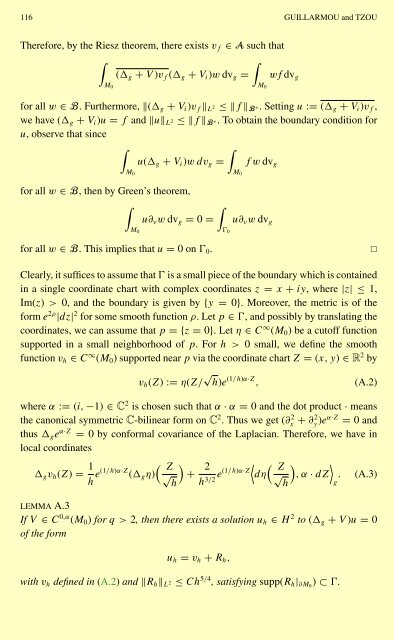NEAR OPTIMAL BOUNDS IN FREIMAN'S THEOREM
NEAR OPTIMAL BOUNDS IN FREIMAN'S THEOREM
NEAR OPTIMAL BOUNDS IN FREIMAN'S THEOREM
Create successful ePaper yourself
Turn your PDF publications into a flip-book with our unique Google optimized e-Paper software.
116 GUILLARMOU and TZOU<br />
Therefore, by the Riesz theorem, there exists vf ∈ A such that<br />
<br />
<br />
(g + V )vf (g + Vi)w dvg = wf dvg<br />
M0<br />
for all w ∈ B. Furthermore, (g + Vi)vf L2 ≤fB∗. Setting u := (g + Vi)vf ,<br />
we have (g + Vi)u = f and uL2 ≤fB∗. To obtain the boundary condition for<br />
u, observe that since<br />
<br />
M0<br />
<br />
u(g + Vi)wdvg =<br />
for all w ∈ B, then by Green’s theorem,<br />
<br />
<br />
u∂νw dvg = 0 =<br />
M0<br />
Ɣ0<br />
M0<br />
M0<br />
fwdvg<br />
u∂νw dvg<br />
for all w ∈ B. Thisimpliesthatu = 0 on Ɣ0. <br />
Clearly, it suffices to assume that Ɣ is a small piece of the boundary which is contained<br />
in a single coordinate chart with complex coordinates z = x + iy, where |z| ≤1,<br />
Im(z) > 0, and the boundary is given by {y = 0}. Moreover, the metric is of the<br />
form e 2ρ |dz| 2 for some smooth function ρ.Letp ∈ Ɣ, and possibly by translating the<br />
coordinates, we can assume that p ={z = 0}. Letη ∈ C ∞ (M0) be a cutoff function<br />
supported in a small neighborhood of p. Forh>0 small, we define the smooth<br />
function vh ∈ C ∞ (M0) supported near p via the coordinate chart Z = (x,y) ∈ R 2 by<br />
vh(Z) := η(Z/ √ h)e (1/h)α·Z , (A.2)<br />
where α := (i, −1) ∈ C 2 is chosen such that α · α = 0 and the dot product · means<br />
the canonical symmetric C-bilinear form on C 2 . Thus we get (∂ 2 x + ∂2 y )eα·Z = 0 and<br />
thus ge α·Z = 0 by conformal covariance of the Laplacian. Therefore, we have in<br />
local coordinates<br />
gvh(Z) = 1<br />
h e(1/h)α·Z (gη)<br />
<br />
Z√h<br />
<br />
+ 2<br />
<br />
Z√h<br />
<br />
e(1/h)α·Z dη ,α· dZ . (A.3)<br />
h3/2 g<br />
LEMMA A.3<br />
If V ∈ C 0,α (M0) for q>2, then there exists a solution uh ∈ H 2 to (g + V )u = 0<br />
of the form<br />
uh = vh + Rh,<br />
with vh defined in (A.2) and RhL 2 ≤ Ch5/4 , satisfying supp(Rh|∂M0) ⊂ Ɣ.

















